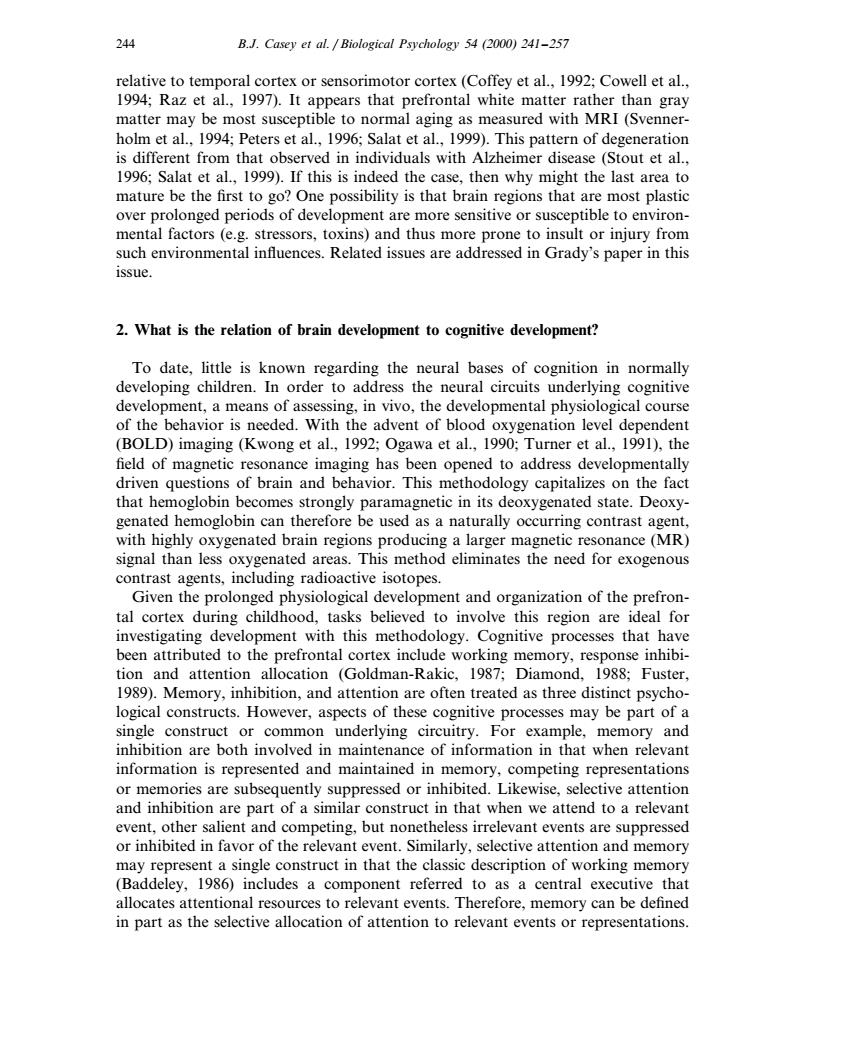正在加载图片...

244 B.J.Casey et al./Biological Psychology 54(2000)241-257 relative to temporal cortex or sensorimotor cortex(Coffey et al.,1992:Cowell et al. 1994;Raz et al.,1997).It appears that prefrontal white matter rather than gray matter may be most susceptible to normal aging as measured with MRI(Svenner- holm et al.,1994;Peters et al.,1996;Salat et al.,1999).This pattern of degeneration is different from that obse rved in individuals with alzhe disease (Stout et al 1996 Salat al1999).If this is in d the then why might the last are mature be the regions that ar e most plast over prolonged periods of development are more sensitive or susceptible to environ- mental factors (e.g.stressors,toxins)and thus more prone to insult or injury from such environmental influences.Related issues are addressed in Grady's paper in this issue 2.What is the relation of brain development to cognitive development? To date,little is known regarding the neural bases of cognition in normally developing children.In order to address the neural circuits underlying cognitive development,a means of assessing,in vivo,the developmental physiological course of the behavior is needed.With the advent of blood oxygenation level dependent (BOLD)imaging (Kwong et al.,1992;Ogawa et al.,1990:Turner et al.,1991).the field of imaging has been opened to address developmentally que of bra and behavior.This me gy cap n the fact that its gen ed 1 globin strongly param agnetic 1 Deoxy therefore be use d as a naturally occurring contrast agent with highly oxygenated brain regions producing a larger magnetic resonance(MR) signal than less oxygenated areas.This method eliminates the need for exogenous contrast agents,including radioactive isotopes. Given the prolonged physiological development and organization of the prefron- tal cortex during childhood tasks believed to involve this region are idea for investigating de ent with this methodolo ognitive pro esses that have ex I g m inhib d attentio (G an-Ra 1987 1989).Memory,inhibition,and attention are often treated as three distinct psycho logical constructs.However,aspects of these cognitive processes may be part of a single construct or common underlying circuitry.For example,memory and inhibition are both involved in maintenance of information in that when relevant information is represented and maintained in memory,competing representations or memories are subsequently suppressed or inhibited.Likewise,selective attention and inhi 10 of a in that en we attend to a relevan ent and c competing,but n ss irrelevant events are s or inhibited in favor of the relevant event.Similarly,selective attention and memory may represent a single construct in that the classic description of working memory (Baddeley,1986)includes a component referred to as a central executive that allocates attentional resources to relevant events.Therefore,memory can be defined in part as the selective allocation of attention to relevant events or representations. 244 B.J. Casey et al. / Biological Psychology 54 (2000) 241–257 relative to temporal cortex or sensorimotor cortex (Coffey et al., 1992; Cowell et al., 1994; Raz et al., 1997). It appears that prefrontal white matter rather than gray matter may be most susceptible to normal aging as measured with MRI (Svennerholm et al., 1994; Peters et al., 1996; Salat et al., 1999). This pattern of degeneration is different from that observed in individuals with Alzheimer disease (Stout et al., 1996; Salat et al., 1999). If this is indeed the case, then why might the last area to mature be the first to go? One possibility is that brain regions that are most plastic over prolonged periods of development are more sensitive or susceptible to environmental factors (e.g. stressors, toxins) and thus more prone to insult or injury from such environmental influences. Related issues are addressed in Grady’s paper in this issue. 2. What is the relation of brain development to cognitive development? To date, little is known regarding the neural bases of cognition in normally developing children. In order to address the neural circuits underlying cognitive development, a means of assessing, in vivo, the developmental physiological course of the behavior is needed. With the advent of blood oxygenation level dependent (BOLD) imaging (Kwong et al., 1992; Ogawa et al., 1990; Turner et al., 1991), the field of magnetic resonance imaging has been opened to address developmentally driven questions of brain and behavior. This methodology capitalizes on the fact that hemoglobin becomes strongly paramagnetic in its deoxygenated state. Deoxygenated hemoglobin can therefore be used as a naturally occurring contrast agent, with highly oxygenated brain regions producing a larger magnetic resonance (MR) signal than less oxygenated areas. This method eliminates the need for exogenous contrast agents, including radioactive isotopes. Given the prolonged physiological development and organization of the prefrontal cortex during childhood, tasks believed to involve this region are ideal for investigating development with this methodology. Cognitive processes that have been attributed to the prefrontal cortex include working memory, response inhibition and attention allocation (Goldman-Rakic, 1987; Diamond, 1988; Fuster, 1989). Memory, inhibition, and attention are often treated as three distinct psychological constructs. However, aspects of these cognitive processes may be part of a single construct or common underlying circuitry. For example, memory and inhibition are both involved in maintenance of information in that when relevant information is represented and maintained in memory, competing representations or memories are subsequently suppressed or inhibited. Likewise, selective attention and inhibition are part of a similar construct in that when we attend to a relevant event, other salient and competing, but nonetheless irrelevant events are suppressed or inhibited in favor of the relevant event. Similarly, selective attention and memory may represent a single construct in that the classic description of working memory (Baddeley, 1986) includes a component referred to as a central executive that allocates attentional resources to relevant events. Therefore, memory can be defined in part as the selective allocation of attention to relevant events or representations